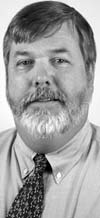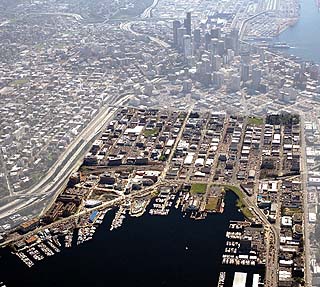
Surveys
DJC.COM
July 29, 2004
South Lake Union: a model for sustainability
Vulcan Inc.

Hazelhurst
|
Surrounded by increased pollution, congestion and waste, we as a society are increasingly seeking new solutions to decrease our exposure to pollutants, reconnect to nature and conserve our planet's natural resources. This is especially true in the Pacific Northwest, where we place an extra emphasis on preserving open space and managing our resources wisely.
In Seattle's South Lake Union neighborhood, exciting efforts are under way to foster an entire neighborhood that embraces sustainability on all fronts — from buildings, parks and public transportation to streetscapes, stormwater capture and re-use, and more.
At its most basic level, sustainable development focuses on developing in urban areas that thrive on more density, as opposed to developing in outlying areas that contribute to suburban sprawl and encroachment on our undeveloped eco-systems. Surrounded by the highly populated Queen Anne and Capitol Hill neighborhoods, South Lake Union is one of the last in-city neighborhoods that can significantly absorb more density.
Integrated transportation

Image courtesy Vulcan Inc.
South Lake Union is one of the last in-city neighborhoods that can absorb significantly higher density. |
During the next 20 years, the city of Seattle forecasts that South Lake Union will be home to 20,000 new jobs and 10,000 new residents. To prepare for this influx in growth, the city is studying and developing several strategies for transportation improvements in the area. For example, the proposed Seattle streetcar will connect South Lake Union and Denny Triangle to downtown's Westlake Center transportation hub, where commuters will be able to connect with the monorail, Sound Transit light rail and the bus tunnel.
By developing integrated systems that get people out of their cars, this will further the efforts to make it a truly sustainable, eco-friendly neighborhood. Fewer cars mean less pollution and less traffic.
Healthy homes, offices
One of the most impactful ways to foster a sustainable community is to start with the physical environment — namely, the structures in which we work and live.
Sustainable development provides a framework for buildings to use energy and other resources efficiently, conserve water, "green" the building site, promote the use of environmentally sensitive or recycled materials, and protect and enhance the quality of life for occupants.
Unfortunately, in most conventional buildings the interrelationship between the building's components, its internal and external environments, and its occupants are often overlooked.
However, new "high-performance" sustainable buildings run efficiently and relatively inexpensively while providing a healthy and more comfortable place where people can perform well. This is accomplished through features such as systems which improve air quality, enhanced natural daylight, non-toxic materials, personal climate controls and more.
Healthy buildings foster healthy workers, and healthy workers are more productive, particularly when they are more comfortable too.
In South Lake Union, several new buildings have been designed and constructed with sustainable attributes. New green developments in South Lake Union include:
Residents are drawn to the many green features of the project, including a roof-deck P-patch for organic gardening (which is irrigated with reclaimed rainwater), water-efficient landscaping, non-toxic paint and flooring, energy-efficient appliances, a Flexcar program to reduce vehicle use and recharging stations for electric cars.
In addition, Alcyone was constructed with many high-recycled-content materials and more than 80 percent of construction waste was recycled. Located at Thomas Street and Minor Avenue, Alcyone was developed by Harbor Properties and Vulcan.
The project is planned to be Seattle's first mixed-use project that is LEED-certified and it will feature increased natural daylight for residents and workers, access to fresh air through operable windows, accessible green rooftops, and low energy and water consumption fixtures and appliances. Energy-saving windows and extra insulation in floors, walls and ceilings will also be in the design.
A special light well will run through the core of the building to provide office workers with additional access to daylight and fresh air from the interior of the building.
223 Yale will be partially constructed with recycled and environmentally sensitive building materials, and will use an aggressive recycling program for construction waste.
Located between John and Thomas streets and Yale and Pontius avenues, the project is under development by Pemco and Vulcan.
Located at Westlake Avenue and Thomas Street, the SBRI Building opened in March. Constructed with a number of recycled materials, the development also features building systems designed to reduce potable water use by 20 percent and energy use by 30 percent more than the industry's most stringent standards.
Non-toxic finishes and an air system that uses 100 percent fresh, outside air also contribute to the healthy and safe indoor environment.
The SBRI Building was developed by Vulcan, Harbor Properties and SBRI.
Green parks, streets
Work on a $1.15 million renovation of the neighborhood's Cascade Park recently started, with a special focus on eco-friendly, sustainable improvements. Vulcan, Pemco and Harbor contributed $650,000 to help fund the city's renovation project.
Improvements include water quality and conservation enhancements that increase the park's pervious surfaces and divert stormwater runoff into a manmade stream that runs through the center of the park. Construction crews will divert more than 50 percent of the construction waste from landfills through recycling and reuse. The park also has been designed with a play structure made of 80 percent recycled materials.
The renovated park will feature vegetative cover, food supply and water to provide habitat and sustenance to small wildlife and birds.
"Green streets" are another important component of the South Lake Union sustainability plan. For example, when developing Alcyone, Vulcan and Harbor wanted to connect residents with the natural environment. Because the apartments are located across the street from the park, great access to green space is provided.
The team worked with the community to integrate Alcyone into the park by creating wide, pedestrian-friendly sidewalks that are landscaped with mature vegetation and large trees. The increase in vegetation helps to create a more natural setting in the urban environment, reduces ambient temperature by providing shade, and attenuates stormwater runoff with natural evaporation and infiltration.
With South Lake Union positioned to be a major growth center for the region, both in terms of jobs and residents, it presents a major opportunity for the sustainability movement to discover new ways to use strategies that will enhance our urban environment and living experience.
There is still a lot of work left to do, but the opportunity to take such a high-profile, bustling neighborhood and turn it into a model for sustainability will set the bar for future redevelopment projects across the country.
Hamilton Hazlehurst is a real estate development manager for Vulcan Inc. Vulcan manages a diverse development portfolio that includes nearly 60 acres in Seattle's South Lake Union neighborhood.
Other Stories:
- Conditional closures — another cleanup remedy
- Guy Battle: design and build to suit your climate
- Washington tests watershed management
- Todd Pacific halts a dirty waterfront legacy
- Going green? Try calling on your contractor
- Emerald City must fight to stay green
- Seattle prepares to ‘re-green' 2,500 acres
- Washington's new paint law gets the lead out
- Putting a price tag on nature
- Contractor finds silver at new headquarters
- Government finds gold at Sea-Tac Airport
- Quick Duwamish cleanup begins with teamwork
- 2004: A great year for the local environment
- Getting to compliance with a systems approach
- Don't let your site be taken to the cleaners
- Salmon get a boost from technology
- Low-impact development comes to Pierce County
- Energy Star label now ready for homes
- Improving traffic flow for fish, people
- Troubling times for Hood Canal's waters
- Utilities to study energy coming into homes
Copyright ©2009 Seattle Daily Journal and DJC.COM.
Comments? Questions? Contact us.